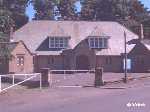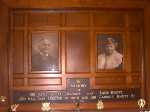KNOTT MEMORIAL HALL
|
(Click the image to see
a larger version)
|
|
The Knott Memorial Hall was given to the village of Heddon
by Sir T. Garbutt Knott, in memory of his parents, Sir James and Lady
Margaret Annie Knott.
Initially the hall was to be a more elaborate construction,
these initial plans included higher wings at the north east and south
west corners to provide a news and games room at one end and a caretakers
flat at the other.
In view of the relatively small size of the village, at that
time, and the existing news and games room at the Men's
Institute, and the availability of other meeting rooms, it was decided
to scale down the plans and use the money saved to create an endowment
fund to assist with the future upkeep of the hall.
|

|
|
(Panel in entrance hall )
|
|

|
This suggestion was agreed to by Sir Garbutt and his legal advisors and the
Hall in its present form was subsequently built in 1936.
The site upon which it was built formed part of the Church Banks, this had
been for many years previous an unofficial playground for the village children.
Mr. L.Walton - Taylor of Heddon and Newcastle was the architect and the Hall
was built by Messrs. Lowry of Newcastle. The original official opening ceremony
was to have taken place on Saturday the 18th July, 1936 at 3pm by Lt.Col.
Sir Alexander Leith, Bart, M.C; D.L, and the dedication service by the Venerable
Archdeacon of Northumberland, a tea to be provided for all invited guests.
The tragic death of the vicar, The Rev. Harold Nixon, in a motoring accident
in Wales, whilst on holiday brought a sudden cancellation of these plans.
It was later officially opened by Mrs.G.E. Wilkinson of Wylam and dedicated
by the Lord Bishop Billrough, of Newcastle, on the 24th October, 1936.
The Hall has a spacious stage with a green room on its north side, the main
hall which is 54 ft. long and 30 ft. wide and its annex 16ft x 30 ft. and
its original floor was of polished birch and inlaid to mark out a badminton
court. It also has a well furnished kitchen, ladies and gents cloakrooms
and toilets.
The hall was requisitioned by the War Office in the period 1939-45 and was
used for the billeting of troops. After the war it was requisitioned by
Northumberland County Council and after the installation of boilers and ovens
it was used as a central kitchen for the provision of school meals for the
surrounding area.
(Click the image to see a larger version) |
In 1954 the hall was returned to the village. It was in a deplorable state
when it was returned to the Trustees after these two periods of occupation,
even a grand piano had vanished.
A good part of the restoration costs were born by the authorities
responsible for its requisitioning but a considerable sum of money was
taken from the hall funds to cover part of the cost and other items not
paid for by the authorities, when it was found to be in need of extensive
repairs. After protracted discussions the authorities did agree to fund
part of the restoration costs, but the balance had to come from hall funds.
|
 |
A Hall Committee was formed and takes responsibility for the running of the
hall and the setting of charges for it's use. The Hall was purchased for
a nominal charge by the Parish Council on 2nd April, 1991.


